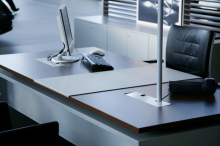Eight steps towards an empty desk every morning
Datum: 2011-01-19 10:01

Do you get easily distracted by all the papers on your desk when you really need to focus on a particularly difficult, complicated or urgent task?
Do these papers and piles concern other things and tasks which you are not dealing with right now, but which are ”in line”, waiting for their turn to be completed?
What if you could “be left alone” by all these distractions and be able to work focused with the one task at hand which is the right one to do right now?
Surely it would be nice to have plenty of space to spread out all the material you need to get an overview and easier solve the task you are working on now?
Well, I believe an empty desk would do you good.
How empty is ”empty”?
When I say empty, I don’t mean empty and desolate and as in an IKEA store, but just emptied of any material you’re not using and need right now, that is, piles, loose notes, magazines and newspapers you should read, finished cups of coffee, et c.
If your desk was emptied of this clutter, you would have the opportunity to decide for yourself what visual impressions you are getting when you need to work focused without getting distracted or disturbed by things which are irrelevant at the moment.
The eight steps
Take these concrete steps towards getting an empty desk.
- Get an inbox, so that all the material which enters you office has a designated landing– strip, instead of ending up scattered on the desk.
- Have your to-do-list in a digital format (that is, on the computer), so that you don’t have to see all the things you don’t have time to do now once you have prioritized what the right thing to do right now is.
- Get a tickler file (http://en.wikipedia.org/wiki/Tickler_file) for all the documents you know you will need at some point in the future and which you would like to keep track of but not have right in front of you until then so that you won’t miss them when you need them.
- Adjust your system for reference material, so that it’s unambiguous, easy to get an overview of, easy to expand, easy to store away into and extract things from. Make sure to always have empty folders or binders available so that you don’t have to interrupt whatever you are ”in the middle of” to run to the supply-room and get more when you need some.
- Get a wastebasket with compartments, that is, a wastebasket or wastepaper basket with two separate compartments, or if you don’t have that, simply get two separate baskets. Fill the first one, fill the second, then empty the first one before starting to fill it up again. When it’s full as well, empty the second and start to fill that instead. Since you have the time of “one basket” to regret your disposal of things, you will feel much more comfortable with throwing things away.
- Every time you sit down by your desk, empty notes, meeting notes and whatever you carry on you into the inbox from which you then can make decisions on what every note means to you and where it really belongs.
- Clear your desk before going home every afternoon, so that it’s empty every morning when you arrive at the office. Then it’ll be much easier to keep it clean and empty throughout the day. Three Dutch scientists who did a study in December of 2008 arrived at the conclusion that the number of people who broke a rule increased by 303% when they saw that someone else had broken the same rule before them. The same goes for us and our desks. If you start leaving papers about, the piles will mount fast. Tough, but true.
- Start again with structuring your desk as soon as it starts to fill with clutter, no matter how many times you have to do it. Never give up – no one is hopeless!
Not feeling too comfortable?
You might say ”Yes, but…I need to have it all out and about on the desk to know what I have to do”. Is that really the smartest way for you to get an overview? Is there some other way for you to keep track of all your big and small ongoing projects? A list of all your ongoing tasks and their next, concrete to-do-tasks or steps?
Focus easier
If you take these steps, you will feel in charge of your own planning. You will be able to easier focus on the task you are prioritizing at the moment and you will leave the office after an intensive workday with a greater sense of satisfaction.
How do you do it?
What’s your method of keeping your desk cleared of anything that doesn’t belong there at the moment?
Feel free to comment below!




